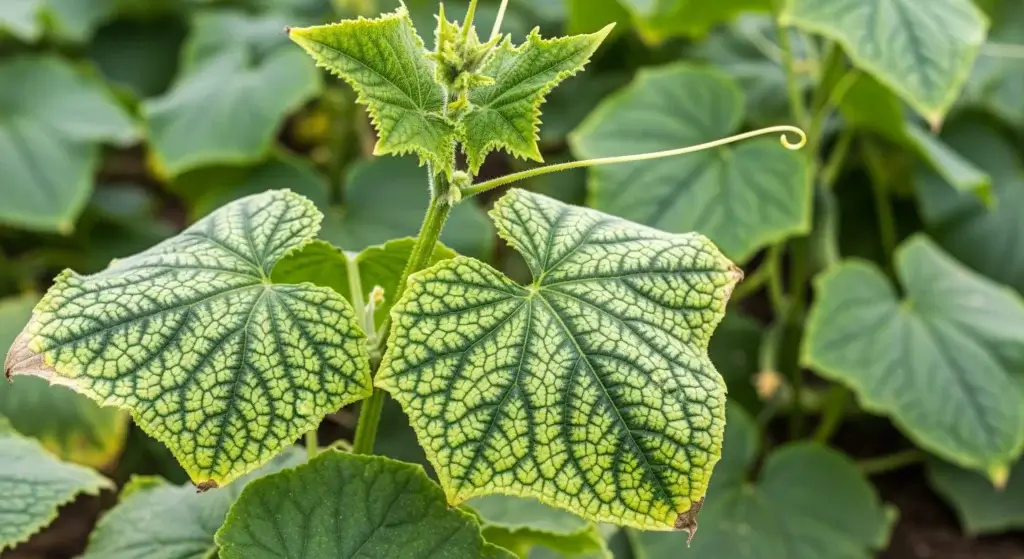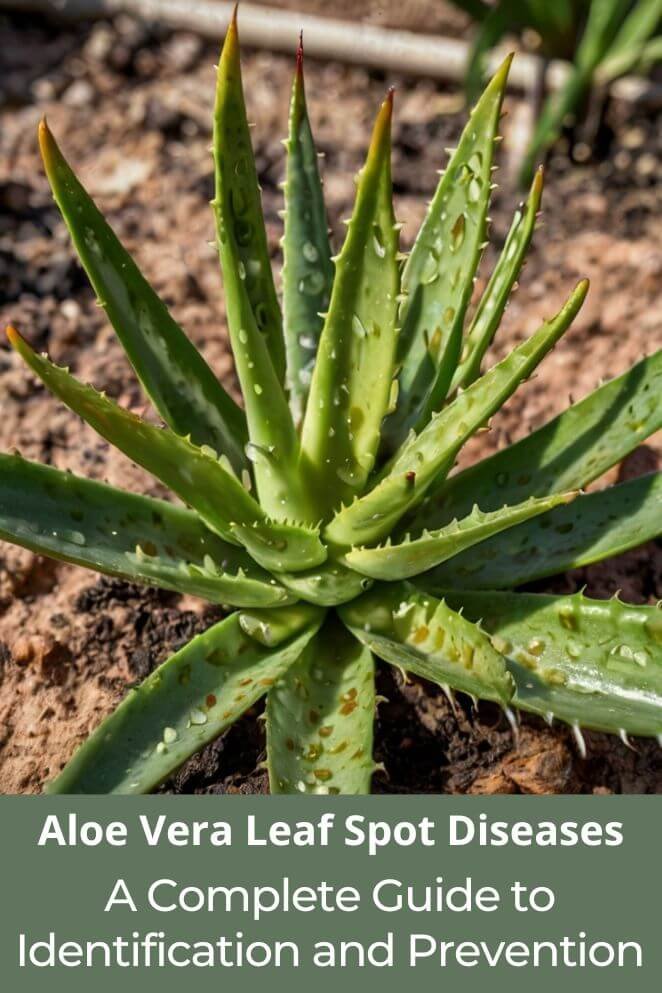
Aloe vera—aka the Beyoncé of houseplants—is chill, healing, and usually flawless.
But even she gets hit with leaf spot drama (think plant acne).
If your aloe’s getting spotty, don’t freak.
It’s common, it’s treatable, and it happens everywhere—from farms to window sills.
Knowing what causes it helps keep your aloe thriving, pretty, and ready to slay that sunny windowsill life.
Understanding Aloe Vera Leaf Spot Diseases
Leaf spots on your aloe? Yep, that’s a thing—and it’s usually fungi crashing the party.
These little troublemakers show up as brown, black, or sunken spots on those thick aloe leaves, slowly turning your chill houseplant into a sad, spotty mess.
Left untreated, they can mess with the gel quality, ruin the plant’s vibe, and in worst cases, kill it. (Rude.)
Here’s the fungal hall of shame:
- Alternaria is the OG villain—spreads fast, loves moisture, and throws dark brown spots all over like it’s decorating.
- Fusarium proliferatum comes in hot with weirdly shaped, sunken marks. It’s picky about where it strikes but hits hard.
- Nigrospora oryzae is the new kid on the block, but it’s already causing drama in aloe communities.
- And then there’s aloe rust, courtesy of Phakopsora species, which leaves dark circular spots that look more like iron oxidizing than a plant infection.
Knowing your enemy is step one. Spot the signs, act fast, and keep your aloe living its best, spot-free life.
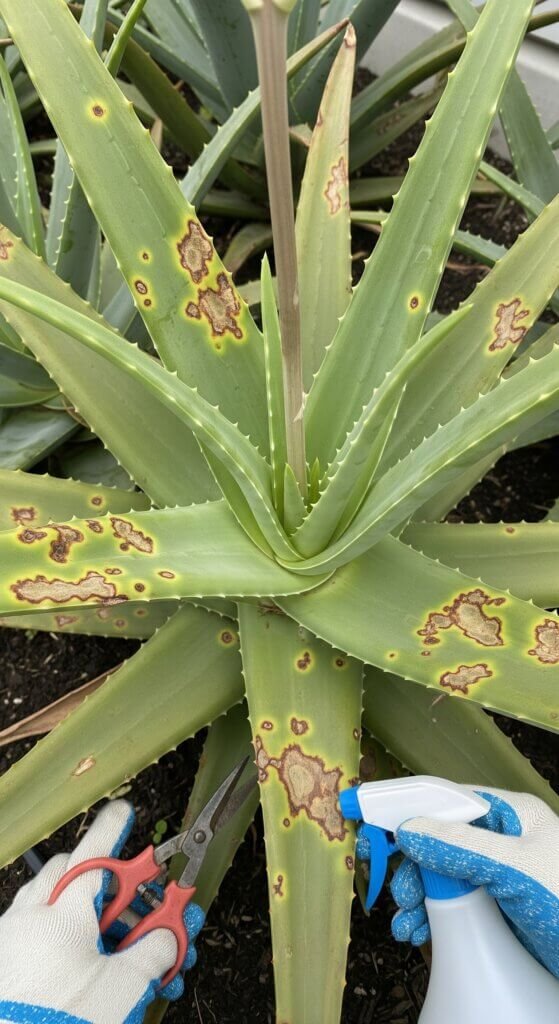
Identifying Leaf Spot Disease Symptoms
Spotting leaf spot early on your aloe vera is basically plant parent 101—because once those funky marks spread, it’s game over for your green buddy’s good looks and health.
Here’s what to look for (before things go full drama):
Stage 1: “Huh, what’s that?”
You’ll notice tiny, water-soaked dots popping up—dark green or brownish, like your aloe got splashed with something shady.
At first, they seem harmless, like plant pimples.
But don’t be fooled. That’s how fungal infections start their takeover.
Stage 2: “Okay, this is getting worse.”
Those little dots? Yeah, they grow. Fast.
We’re talking from millimeters to full-blown blotches (2–8 cm across).
They go from subtle to “I can’t unsee this,” with tan or light brown centers and darker edges—kind of like a gross latte ring on your leaf.
Stage 3: “Houston, we have a problem.”
When spots start merging into mega-patches, you’ve officially entered crisis mode.
Your aloe leaf might even start to sag or cave in (especially if it’s Fusarium—that one’s a heavyweight).
The tissue goes mushy, the structure weakens, and the whole thing looks like it lost a fight with a fungal army.
Environmental Factors Contributing to Disease Development
Most aloe vera leaf spot issues start not with the plant, but with its vibe being totally off.
Fungus doesn’t just show up for fun—it needs the right conditions to throw its spore party.
Here’s how your aloe might be (accidentally) sending out those unwanted invites:
Climate and weather conditions
- High humidity (over 80%)? That’s basically spring break for fungi. Think of your aloe chilling in a mini rainforest—it’s wet, it’s warm-ish, and it’s ripe for infection.
- Cool + moist = fungal jackpot. When temps dip and humidity stays up (hello, winter), leaf spot pathogens go full beast mode.
- Leaves that stay wet too long—from misting, rain, or an overzealous watering session—become Airbnb hosts for spores.
- Stuffy, crowded plant corners = zero airflow. And when there’s no breeze? Moisture lingers, spores spread, and your aloe gets sweaty in all the wrong ways.
Cultural factors
- Overwatering is aloe’s biggest ick. It’s a desert diva, not a swamp creature. Too much moisture = stressed-out plant with a “come infect me” sign.
- Bad drainage means soggy soil and fungal vibes from the ground up. Aloe wants that dry, gritty, drain-fast lifestyle.
- Too-close quarters with other plants kills air circulation, turning your windowsill into a leaf spot hotspot.
- Stressed or injured plants (from rough handling, extreme temps, or poor nutrition) are like sitting ducks. Fungi love a weak immune system.
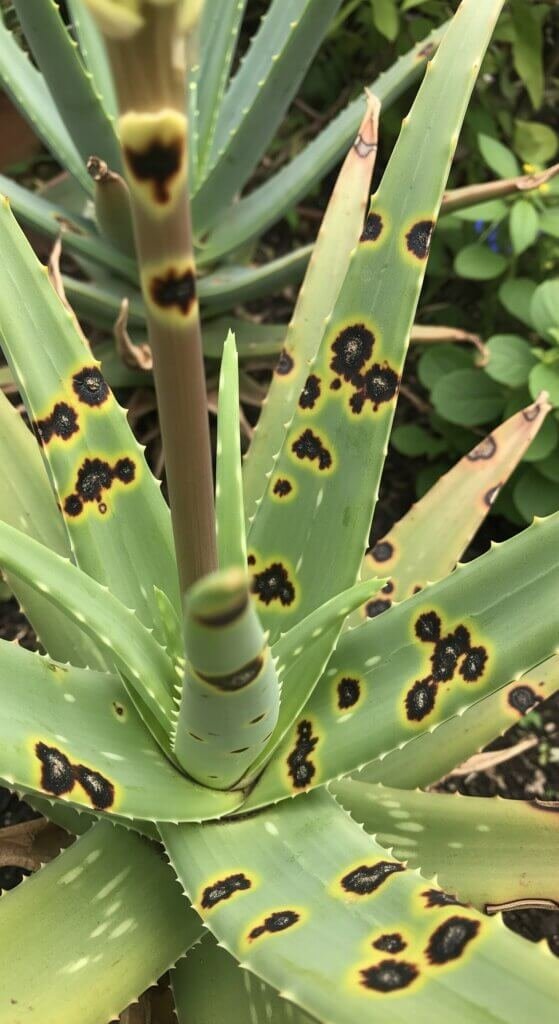
Prevention Strategies for Leaf Spot Diseases
Alright, let’s talk aloe leaf spot prevention.
Here’s how to keep your aloe looking sharp and spot-free, like the glossy green influencer it was born to be:
Environmental management
- Keep things breezy. Good airflow = bad news for fungus. Give your aloe some personal space, especially indoors.
- No crowding. Imagine your plants in a mosh pit—humid, sweaty, and not cute. Space them out so air can move freely. More air = fewer spores sticking around.
- No water on the face, please. Aloe isn’t into overhead showers. Water the soil, not the leaves.
- Drain like a pro. Soggy roots? Instant drama. Use cactus/succulent mix, and make sure your pots have actual drainage holes (not just vibes).
Cultural practices
- Water less, but better. Aloe likes the “wait for my texts” kind of care—ignore it for a bit, then show up with a deep soak. Let the soil dry out completely between waterings.
- Give it the once-over. Check your aloe weekly like you’re doing a wellness check on your bestie’s ex. Look under leaves, at the base—any sketchy spots? Nip ‘em early.
- Keep it clean. Dirty tools spread disease faster than TikTok trends. Wipe your shears. Toss fallen leaves. Think: plant hygiene = plant health.
- New plant? Quarantine mode. That new aloe from the nursery could be bringing fungal drama.
Treatment Options for Infected Plants
Alright, so your aloe caught the fungal flu.
Don’t panic—this isn’t a plant funeral, it’s a rescue mission. Let’s talk treatment.
Step 1: Immediate response measures
- Snip the sick stuff. Grab your scissors (clean them first—this isn’t a crime scene), and cut off the spotted leaves.
- Give it space. Fungus loves cramped, moist quarters. Move the infected plant away from the rest like it’s grounded. Better airflow = less fungal party time.
- Ease up on the water. No more daily spa treatments. Let things dry out. Aloe likes its soil like its drama: dry and distant.
- No overhead watering. Keep the leaves dry—fungus thrives in that soggy vibe. Bottom watering or targeted soil soaking is the way to go.
Step 2: Bust out the fungicides
- Call in the big guns. Copper-based sprays or systemic fungicides (the kind that get absorbed and fight from the inside) can take down fungal freeloaders.
- Act fast. Fungicides work best when you hit the infection early. Waiting too long is like bringing a mop to a flood.
- Repeat if needed. You might need more than one round—follow the label, and rotate between types so the fungus doesn’t build resistance like a villain in a sequel.
Step 3: Biological control options
- Go natural. There are helpful microbes—rhizobacteria and friendly fungi—that can outcompete the bad guys.
- Think of it as probiotic therapy. Just like you’d eat yogurt to fight a gut bug, your aloe can benefit from the botanical version.
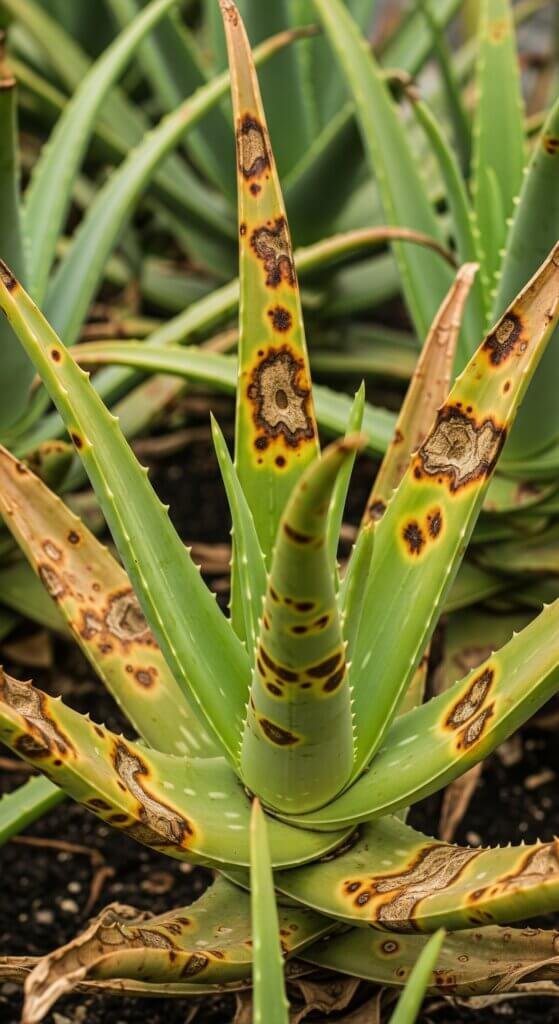
Long-term Plant Health Management
Feed it like you mean it
- Go easy on the nitrogen. Yes, nitrogen makes leaves grow fast, but too much = soft, squishy leaves that are basically a fungal buffet.
- Micronutrients matter. Potassium and phosphorus are like your aloe’s personal trainers—they boost strength, stress resistance, and help the plant fight off future fungal flings.
Give it the VIP suite
- Light, temp, humidity: balance it all. Aloe loves bright, indirect light, warm temps, and low humidity—basically, think desert spa.
- Seasonal shifts? Adjust care. Winter = prime time for leaf spot sneak attacks. Back off the watering and keep airflow strong like you’re prepping for plant flu season.
Be the plant parent who takes nnotes
Track what’s happening. Got a plant journal or a notes app? Use it.
Jot down watering schedules, light levels, any funky leaf stuff, and even weather changes.
Patterns pop up, and your future self will thank you when a spot shows up and you know exactly what triggered it.
Conclusion
Leaf spot on your aloe? Total mood killer.
But with some basic care, you can keep your plant thriving and Instagram-ready.
Remember: prevention > cure.
Treat your aloe like skincare—good daily habits beat emergency fixes.
Healthy aloe = happy, chill plant. Keep it stress-free, and it’ll keep healing, glowing, and looking like the Beyoncé of your plant shelf.

